Outdoor Humans: September 2024, Autumnal Equinox Edition 🍂
Determined to wear a sweater outside, might melt first.
In this month’s issue:
A recap of my recent adventure 149 feet below ground
Recommendations for a few plants you can pop into your fall garden
Your nature questions answered by an oddball who lives in the woods (spoiler: it me)
Did you know squirrels get smarter this time of year? Here’s how.
Plus a few other nature notes.
Hello, friends!
Here it is, the season so many of us have been waiting for. Despite being a very cool person, I cannot deny the alluring call of autumn. But like most Type A perfectionists, I have rules about how I welcome the season. Scarves can’t come out until the weather stays below 70°. I’m not ready to look at pumpkins until early October (any sooner and they rot on the porch). Starbucks and Dunkin’ may have rolled out their syrupy sweet pumpkin drinks in late August, but the autumnal snob in me refuses to imbibe until the first day of fall.
But, aha, Nicole, when does fall truly begin? My 6-year-old asked me last week about the countdown to autumn, and while it’s easy to say “late September” in an effort to mold him into an autumnal equinox purist, the correct answer is actually two dates: Sept. 1 and Sept. 22. Stick with me here and you’ll get the justification you need to celebrate either or both.
Astronomical autumn — aka the one true fall — begins September 22 in 2024. As the Latin name implies, days and nights become briefly and roughly equal in length before the daylight hours lose steam. But here’s the deal: the autumnal equinox isn’t always the same day because it takes Earth 365.25 days to complete its route around the sun. That little calendar mismatch adds up to shift the equinox date, meaning astronomical fall can arrive anywhere from Sept. 21 to 24.
While that’s well and good for those of us willing to usher in fall later in the month, it’s a data pinch point for scientists tracking weather and planetary patterns. To keep data consistent, researchers use meteorological autumn, cemented firmly between Sept. 1 and Nov. 30.
Regardless of when you slip into an autumn state of mind, the season is packed with opportunities to spend time outdoors (perhaps even more than summer). Enjoy September and celebrate the seasonal shift any way you please, on any date that feels right to you.
This month, outdoors
A few ideas of how you can enjoy what nature has scheduled for September
🦇 Cave Girl Summer, Part 2
(Or, a Debrief on Mammoth Cave National Park)
Last August, my husband and I finally had the chance to cross a few distant national parks off our list. We stuffed two small children and an excessive amount of cast iron into a truck with a GPS set for Badlands National Park, along with stops at nearby Jewel Cave and Wind Cave National Parks. Just a few weeks before, we camped at Onondaga Cave State Park in Missouri. Somehow, without any purposeful planning, 2023 became my cave girl summer.
This year, I thought I was done with caves. I wasn’t feeling another drippy underground tour. But when planning a smaller vacation close to home, Mammoth Cave National Park in Kentucky became a top contender. To be honest, I wasn’t jazzed about the idea — partially because I’d been angling for the Southwest, but mostly because Mammoth Cave doesn’t have the same appeal as some of the larger national parks. Park rangers recently joked about this perception after Mammoth Cave was dragged as the country’s third-most disappointing tourist attraction.
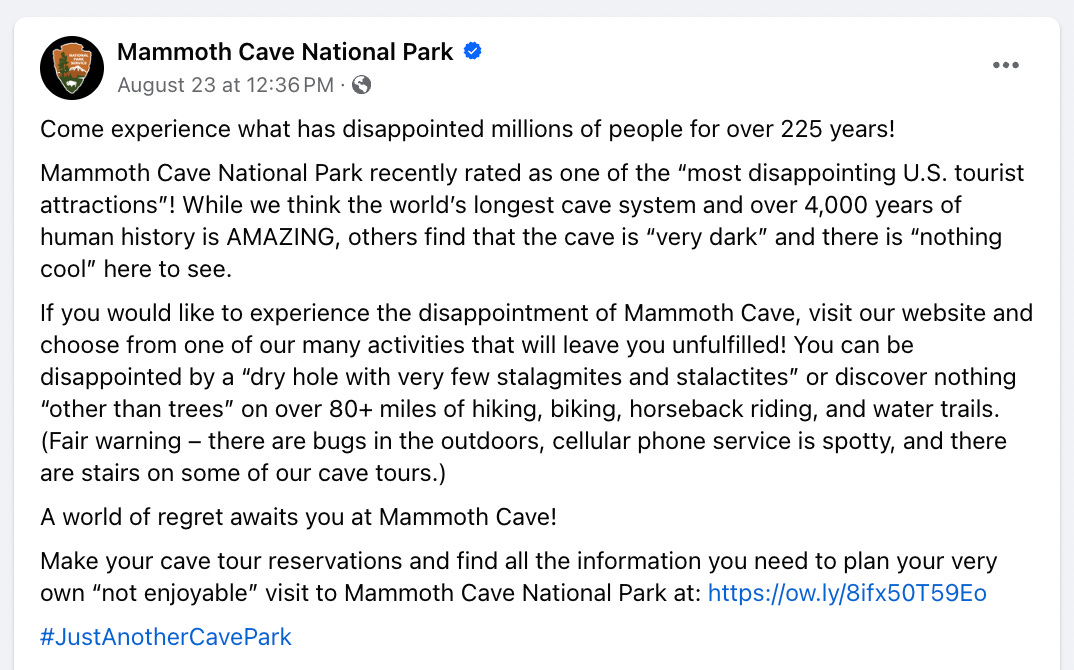
However, the powers at be (aka children high on the power of voting on a vacation destination) set me up for a fantastic time. Here are a few trip highlights and recommendations should you venture out to this underground wonder.
Five Fast Facts About Mammoth Cave
Mammoth Cave is the world’s largest cave system, though no one’s sure of its exact size. More than 400 miles have been mapped, and more are continuously discovered because it’s still forming.
While the cave is about 10–15 million years old, the park was established in 1941 in western Kentucky about 1.5 hours south of Louisville.
Mammoth Cave is a World Heritage Site and Biosphere Reserve, recognized internationally for its historical, scientific, and ecological significance.
Above ground, the park contains 52,830 acres with 70 miles of trail for hiking, biking, and horseback riding, along with river access for water exploration.
The park has three campgrounds, historic cottages, and a motel, making it easy to stay a few days and take in the entire experience.
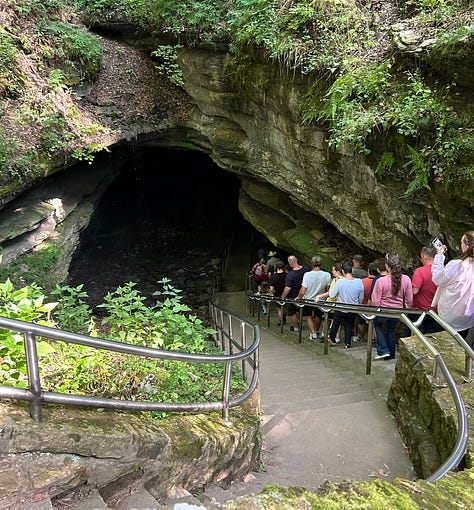
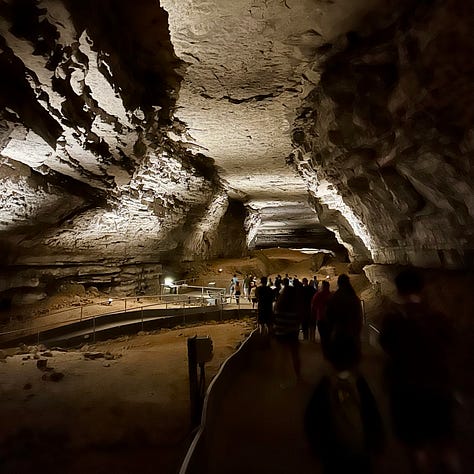
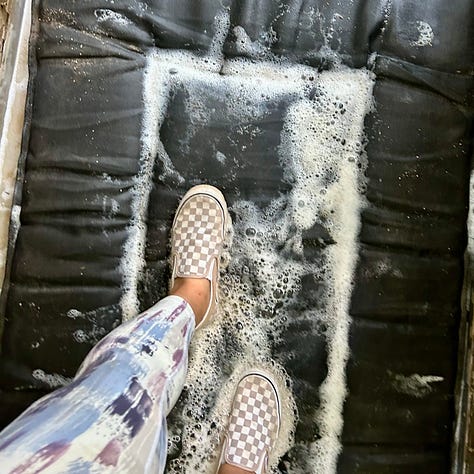
The Main Attraction: Taking a Cave Tour
Our trip to Mammoth Cave happened to sync up with a lovely summer heat wave — not the best for camping, but perfect for spending a few hours in a balmy 54° cave. However, we almost missed our shot at cooling off because we didn’t purchase our tour tickets in advance. August is peak season for many national parks, Mammoth Cave included, which sees around 600,000 visitors each year. To accommodate all those people, rangers lead around 20 separate tours each day, with groups as large as 110 visitors.
By early morning on our arrival day, nearly all tour tickets were sold out (along with most for the following few days). It didn’t help that our choices were somewhat limited because of cave rules; some tours have age or mobility restrictions, or are well over two hours long. With two kids under 6, we snagged the last tickets for the 75-minute Mammoth Passage Tour, an “introductory guided tour” that’s best suited for small children and people with claustrophobia or limited mobility. The tour descended ¾ mile into the cave, where a ranger flipped off the lights briefly to show how dark the passageways are, and gave a detailed history of the cave’s use by native people, saltpeter miners in the early 1800s, and modern explorers.
Unlike many other caves, Mammoth Cave is considered a “dry cave,” meaning it was free of water drops you may experience in other caves. However, you do get your shoes wet at the end in a sanitary scrub rangers jokingly called a “complimentary shoe shine.” That cleaning solution helps curb the spread of white-nose syndrome, a fungal disease that kills bat colonies.
What Else to See and Do at Mammoth Cave NP
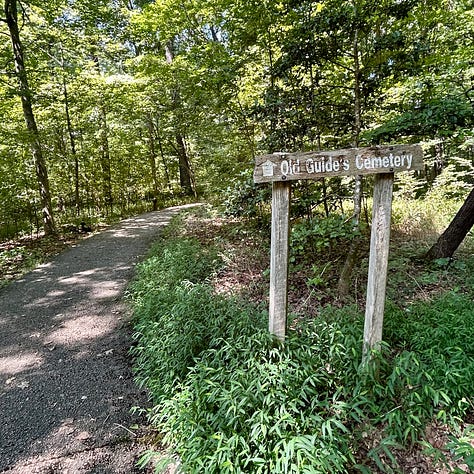
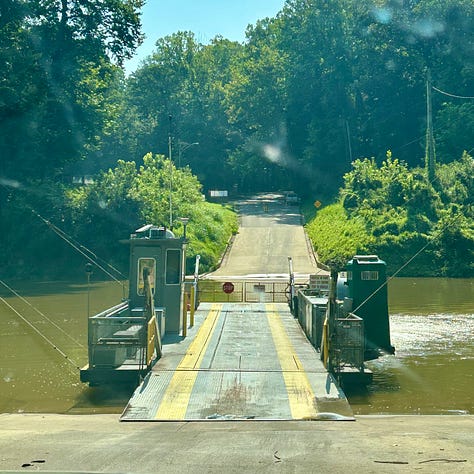

Pay your respects to Stephen Bishop, one of the first Mammoth Cave guides. You’ll find his resting place a short walk from the visitor’s center. Stephen Bishop was an enslaved Black man who worked as a tour guide from the late 1830s through the mid-1850s, during which time he explored and mapped new cave passages. Bishop became such a renowned guide that he led celebrities of the time, such as writer Ralph Waldo Emerson, through Mammoth Cave. Bishop’s cave maps were used for four decades, and despite being enslaved, he was actually credited for his work (a rarity of the time). He attained freedom in 1856 and planned to leave caving behind, but died from illness that same year at age 37. Bishop rests within the Old Guide’s Cemetery, with a headstone that reads “Stephen Bishop, first guide and explorer of the Mammoth Cave.”
Take the junior ranger pledge. NPS’s junior ranger program is a big draw for kids, though anyone can participate. Start by snagging a free booklet from the visitor’s center, which outlines the requirements for getting your badge: participating in a cave tour or ranger program, completing a set of activities within the booklet (such as a scavenger hunt and museum visit), and taking the official junior ranger pledge administered by a park ranger. After swearing in, you’ll get your very own pin-on badge.
Ferry your car across Green River. One entrance to Mammoth Cave National Park requires a water crossing, but luckily you won’t have to caulk and float your car like the Oregon Trail. The Green River Ferry — which has been operational since 1934 — offers a short, free ride across the river for cars, bikes, and hikers. While it typically runs daily, the ferry is paused during low-water conditions, so call the ferry hotline for operating hours before you go.
Get a glimpse of huge bullfrogs from the boardwalk at Sloan’s Crossing Pond. Originally constructed as part of the Civilian Conservation Corp (CCC) project in 1939, the boardwalk around Sloan’s Crossing Pond reopened this spring after major renovations. This nearly half-mile accessible walk puts the marshy water at center stage, letting you view turtles, waterfowl, and other aquatic creatures up close. This was the best part of the entire trip for my frog-obsessed toddler, who enjoyed listening to and spotting some of the largest bullfrogs we’d ever seen.
All national parks have their positives and downsides, Mammoth Cave included, and while there was less to do and see than some of the larger parks, outdoors enthusiasts will likely find something to enjoy there. Drop a comment below about your favorite national park (or least favorite, because they can’t all be winners).
🍈 Locating The Granddaddy of Wild Fruits
All summer, Outdoor Humans has featured fruit you can find out in the woods. As summer turns to fall, there are fewer berries and sweet treats to find, though they’re not all gone. Enter the pawpaw, known as North America’s only native tropical fruit, which looks something like a cross between a mango, papaya and banana. Pawpaws are somewhat mushy and packed with giant seeds, but the inside flesh is sweet. This time of year, deer, turkeys and squirrels will seek out the natural sugar rush, so you better get on it before they do.
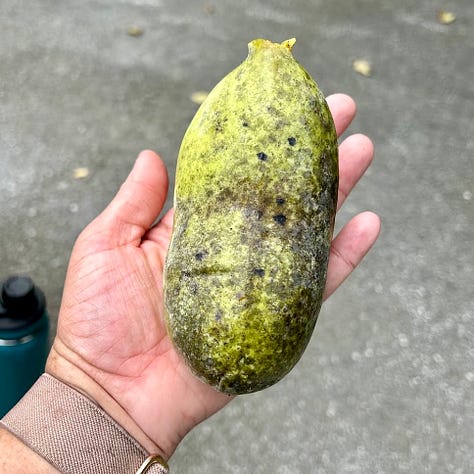
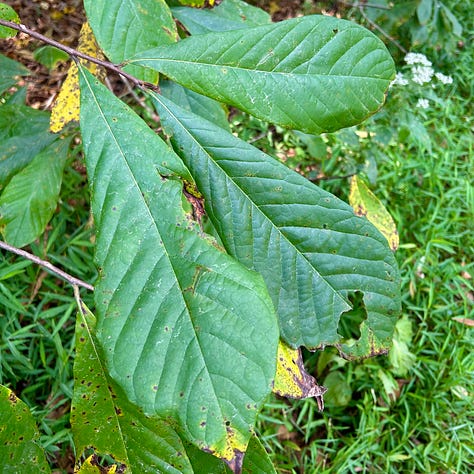
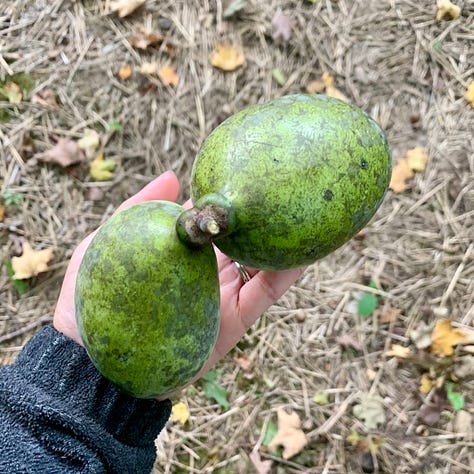
When to hunt: Early autumn
Pawpaws begin ripening and dropping from trees in early September through October. Not all fruit on the same tree or in one area will ripen at the same time, so if you find only a few, keep returning over the next few weeks to collect more.
Where to hunt: Spots with moist soil
Where I’m at in Eastern Missouri, pawpaws are plentiful (after all, they are the state’s official fruit), though their range stretches to the East Coast, topping out into lower parts of Canada and bottoming out in parts of the Sun Belt. If you’re within this region, be on the watch for 20-30 foot trees along creek sides and river bottoms, or spots with particularly moist soil. Pawpaw trees are often found bunched together in groves and can be identified by their massive oval-shaped leaves, between 6 and 12 inches long and up to 5 inches wide. As fall progresses, they’ll transition from a deep green to yellow, and stay on the tree until nearly winter.
How to harvest: Look out, below!
Spotting pawpaws can be tricky — they often blend in with foliage while green, though they slowly ripen to a slightly yellow color, and tend to have brown speckling or shading on the skin. As they ripen, pawpaws will fall to the ground, so watch where you step. Ripe fruit will be firm with a soft give when squeezed, though slightly underripe fruit can be stashed in a brown paper bag on the counter to speed up the process. Give tree trunks a gentle shake to dislodge fruit higher up (just like mulberries earlier this summer).
Foraging notes you should know
Pawpaws last only a few days at room temperature, so use them quickly or stash them in the fridge to extend their shelf life (the pulp can also be frozen after the skin and seeds are removed). There are a million ways to eat pawpaws — I’ve seen recipes for waffles, puddings and bread — however I should note not everyone finds them easy on the stomach when cooked or eaten raw. Avoid eating the skin and seeds for the best possible experience (some sources consider them toxic). As with any wild foraged food, be sure to start with small amounts before gorging yourself to avoid any unsavory reaction.
🥬 Hark! The Time To Plant a Fall Garden is Upon Us!
The countdown to fall frost is on. By this time of year, I’m ready to let go of my summer garden. After months of fighting groundhogs, smooshing squash bugs, and endless weeding, I’m okay with letting the warmer-weather residents of my garden drop their final fruit and go to seed. I’m not done with gardening, though. Instead, I’m dropping in new seeds to my raised beds, typically fast-growing greens that will fill my dinner plate until the winter solstice.
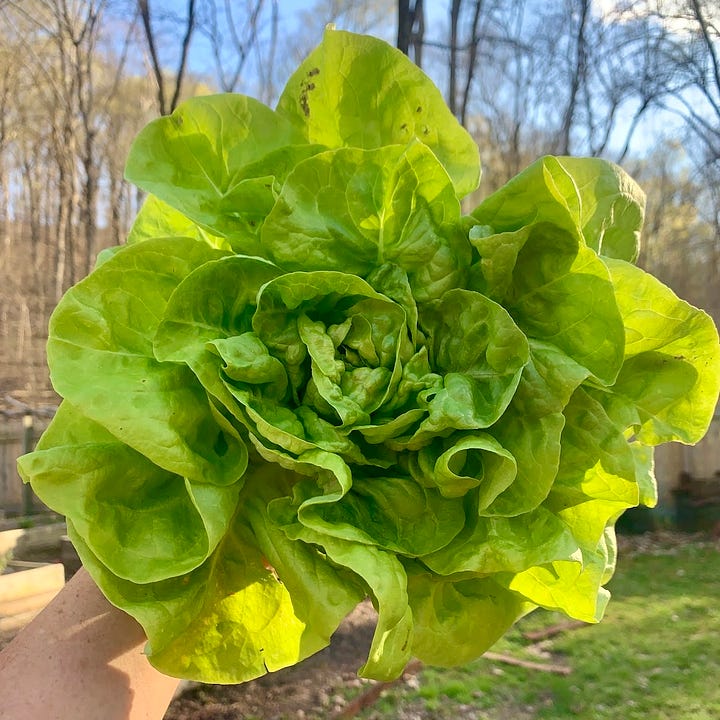
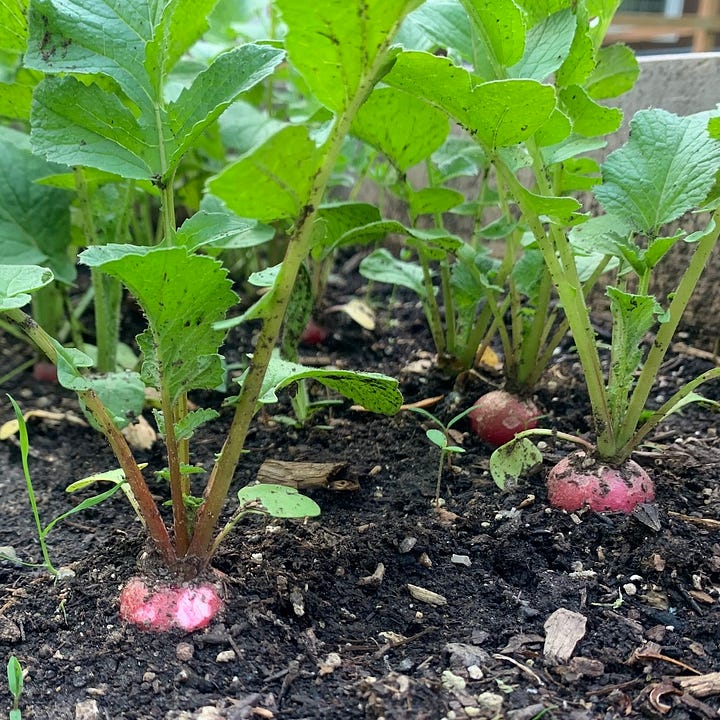
If you’ve never grown a fall garden, I’d highly recommend it. Many heat-intolerant vegetables and leafy greens grow beautifully this time of year with lower temps and fewer pests; some can even be covered with a hoop and plastic and overwintered through next spring, giving you extra produce throughout the cold winter months. I find that fall gardens are a bit more hands-off, and there’s a different kind of joy I get from stepping out to clip lettuce for dinner while wearing a sweater.
Here’s a few of the easy-growing crops I’m tossing in my fall garden for picking through the season, all of which can be sown in-ground, raised beds or porch planters.
Lettuce is a standard fall garden crop. Depending on the variety, you can have lettuce on your plate in under a month (less time for cut greens, more time for lettuce heads to develop).
Mizuna is one of my favorite salad greens because it grows so well and quickly this time of year. It’s ready within 40 days though you can often harvest 20 days after planting, and it’s even tolerant to light frosts.
Radishes do great in cool weather and are exceptionally fast growers, ready in about three to five weeks. I find that fall-grown radishes are a bit more mellow than earlier in the year (warm temperatures can ratchet up their bite).
Do you remember that whole superfood battle between kale and Swiss chard a few years back? You don’t have to choose a side because they’re both great and exceptionally cold tolerant. Plant ‘em both. My favorites are “Russian Red” kales and rainbow chards.
Tatsoi develops beautiful deep-green rosettes as it grows, which you can pick a few leaves from or harvest the entire head. I’ve had plants last through two weeks of 0° temps in my covered raised bed. I’m sold on planting it each fall and prefer it over spinach.
Carrots taste and grow better this time of year, so I like to plant smaller varieties in autumn. My current favorite is the round “Parisian” — it’s frost-hardy, ready in 55 days, and incredibly cute.
Have a fall garden favorite or a question about planting your own? Leave a comment below!
Arrivals, departures, and other nature notes
What to look for on this month’s outdoor adventures
Pine cones are starting to pop off. From now through December, conifer trees drop their pokey pods, which aren’t actually seeds, but seed holders. Younger pine cones remain protectively closed as the seeds develop and open when it’s time to disperse — the entire process can take two to three years. This time of year, I enjoy collecting pine cones as they complete this cycle for use in my fall and yuletide crafts and decor.
You won’t need a rabies shot after meeting this spider. Fall beckons spiders indoors to your warm and cozy abode, raising the chances you’ll come across a few unwanted lodgers some with wild names. Rabid wolf spiders (Rabidosa rabida) are native to North America and can often be found hidden among leaves outdoors, recognizable by their brown and tan stripes. It’s unclear whether the name comes from a description of their quick and erratic movements or a game of Latin telephone, though researchers know these webless spiders are fantastic hunters that chase down other spiders, ants, and flies. Rabid wolf spiders are devoted mothers that carry their egg sacks and recently hatched spiderlings for weeks at a time, and will even return to search for babies dropped during a speedy getaway.
Male squirrels get a brain boost this time of year. Stashing nuts (and remembering where) takes a lot of effort, which is why male squirrels get a memory expansion each fall. During caching season, their hippocampus — aka the portion of the brain responsible for memory — grows to retain that acorn map. Female squirrels don’t experience the same effect; scientists believe their brains may be functioning at that heightened state all year long.
Ask the Woods Witch: Your Nature Questions, Answered 🔮
After responding to a few IRL questions the past month about non-venomous porch spiders, why there are fewer fireflies in newly built subdivisions (😬) and when to start planting a fall garden… I realized I’ve finally arrived. I’m that oddball woods-dweller for whom people save their random nature questions. I relish this. Starting this month, you can submit your random nature and outdoor questions, and I’ll give you a thoroughly researched answer in an upcoming issue of Outdoor Humans. If I don’t know it, I’ll reach out to biologists, experts, and other outdoor enthusiasts to get you a solid answer.
This month’s question comes from Katie C. in Weston, Missouri:
People love paw paws but I’m still not sold on the flavor! What’s a good way to eat them to learn to love them?
How timely! I’ll admit that my very first pawpaw harvest went partially to waste because I wasn’t sure how to use them. Their tangy, custardy flavor and mushy texture is… a lot for your taste buds. I’ve personally eaten pawpaws raw, and that’s been just okay. I have also baked them into a loaf similar to banana bread with great results that mellow out the flavor and mask the texture. Kentucky State University has a trove of recipes including pies, cakes, muffins and even milkshakes! I’m especially looking forward to trying out this baked pawpaw pudding recipe this fall. Let me know how any of these work out by tagging Outdoor Humans on Instagram!
Shameless plugs for my work around the web
This piece I wrote about the origins of popular autumnal spices might inspire you to add a dash of cinnamon to your morning coffee. My favorite part? Fifth-century spice traders used to inflate their prices by claiming cinnamon harvesting was a matter of life and death. Supposedly, merchants had to battle dangerous “winged creatures” for access to cinnamon trees while wearing protective suits made from ox hide. None of this was true, but it hilariously helped rake in those big cinnamon dollars.
That’s it for this month’s edition of Outdoor Humans. Happy autumnal equinox, intrepid nature explorers! We’ll chat again in October.
Thanks for reading, but more importantly: get out there and be an outdoor human!
Nicole Garner Meeker




